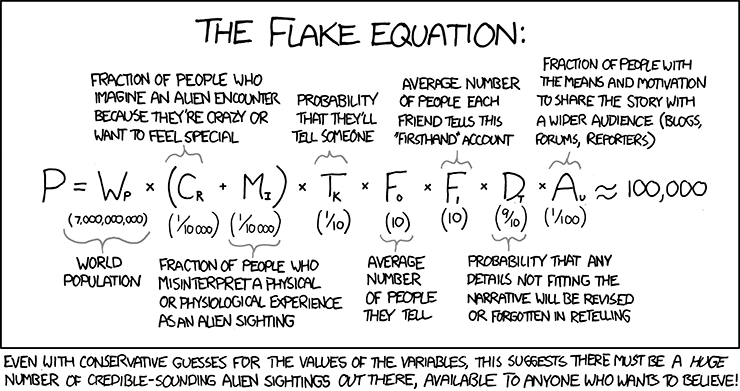http://en.wikipedia.org/wiki/Close_encounter wrote:
<<In ufology, a close encounter is an event in which a person witnesses an unidentified flying object. This terminology and the system of classification behind it was started by astronomer and UFO researcher J. Allen Hynek, and was first suggested in his 1972 book The UFO Experience: A Scientific Inquiry. He introduced the first three kinds of encounters; more sub-types of close encounters were later added by others, but these additional categories are not universally accepted by UFO researchers, mainly because they depart from the scientific rigor that Hynek aimed to bring to ufology.
Sightings more than 500 feet (160 m) from the witness are classified as "Daylight Discs," "Nocturnal Lights," or "Radar/Visual Reports."Sightings within about 500 feet are subclassified as various types of "close encounter." Hynek and others argued a claimed close encounter must occur within about 500 feet to greatly reduce or eliminate the possibility of misidentifying conventional aircraft or other known phenomena.
Hynek's scale achieved cachet with the general public when it informed elements of the 1977 film Close Encounters of the Third Kind, which is named after the third level of the scale. Posters for the film recited the three levels of the scale, and Hynek himself makes a cameo appearance near the end of the film. The Fourth level of the scale, not on Hynek's original version, in turn inspired the 2009 film The Fourth Kind.
--------------------------------------------
___ First
A sighting of one or more unidentified flying objects:
* Flying saucers
* Odd lights
* Aerial objects that are not attributable to known human technology
--------------------------------------------
___ Second
An observation of a UFO, and associated physical effects from the UFO, including:
* Heat or radiation
* Damage to terrain
* Crop Circles
* Human paralysis (Catalepsy)
* Frightened animals
* Interference with engines or TV or radio reception.
* Lost Time: a gap in one's memory associated with a UFO encounter.
--------------------------------------------
___ Third
An observation of what Hynek termed "animate beings" observed in association with a UFO sighting. Hynek deliberately chose the somewhat vague term "animate beings" to describe beings associated with UFOs without making any unfounded assumptions regarding the beings' origins or nature. Hynek did not necessarily regard these beings as "extraterrestrials" or "aliens." Additionally, Hynek further expressed discomfort with such reports, but felt a scientific obligation to include them, at the very least because they represented a sizable minority of claimed UFO encounters.
.........................................
___ Bloecher subtypes
The UFO researcher Ted Bloecher proposed seven subtypes for the close encounters of the third kind in the Hynek's scale.
A: An entity is observed only inside the UFO
B: An entity is observed inside and outside the UFO
C: An entity is observed near to a UFO, but not going in or out.
D: An entity is observed. No UFOs are seen by the observer, but UFO activity has been reported in the area at about the same time
E: An entity is observed. But no UFOs are seen and no UFO activity has been reported in the area at that time
F: No entity or UFOs are observed, but the subject experiences some kind of "intelligent communication"
--------------------------------------------
___ Fourth
A human is abducted by a UFO or its occupants. This type was not included in Hynek's original close encounters scale. Jacques Vallee, Hynek's erstwhile associate, argued that a CE4 should be described as "cases when witnesses experienced a transformation of their sense of reality," so as to also include non-abduction cases where absurd, hallucinatory or dreamlike events are associated with UFO encounters.
--------------------------------------------
___ Fifth
Named by Steven M. Greer's CSETI group, these purported encounters are joint, bilateral contact events produced through the conscious, voluntary and proactive human-initiated or cooperative communication with extraterrestrial intelligence. This is very similar to some "contactees" of the 1950s who claimed regular communication with benevolent aliens.
--------------------------------------------
___ Sixth
On Michael Naisbitt's website, a sixth proposed CE scenario is described as UFO incidents that cause direct injury or death. This category was not included in Hynek's scale, and is furthermore redundant: a CE2 in Hynek's scale specifically included UFO encounters that leave direct physical evidence of any kind.
--------------------------------------------
___ Seventh
The Black Vault Encyclopedia Project proposes a Close Encounter of the Seventh Kind as human-alien hybridisation.[9] This concept similar to ideas promoted by ancient astronauts theorists like Erich von Däniken, Zecharia Sitchin and Robert K.G. Temple, in that extraterrestrials interacted with, perhaps interbred with and influenced ancient human beings in the past.
This concept of CE7 is at odds with Hynek's original concepts, however. Hynek's CE3 specifically avoided describing UFO occupants as "aliens" or "extraterrestrials," contending that there was not enough evidence to determine if beings associated with UFOs had an objective physical reality, let alone to confirm their origins or motives.
--------------------------------------------
___ Eighth
A Close Encounter of the Eighth Kind has been depicted in fiction by television shows such as X-Files, V (science fiction)KV, Alien Nation, Stargate: SG-1, They Live, and First Wave, CE8 refers to possible alien colonization. According to the ancient astronaut theory, extraterrestrials today are producing hybridised human beings to infiltrate key government positions throughout the world in an effort to:
a) continue the alien astronaut philosophy to assist humanity in what these extraterrestrials deem human infancy today and prepare the species for future endeavors,
b) control the world through a New World Order,
c) annihilate human existence for any varying reasons such as damages to the Earth itself or threats to the rest of the universe from human progress and thinking, or
d) a simply, malevolent species bent on eradicating all life other than their own.
--------------------------------------------
___ Ninth
A Close Encounter of the Ninth Kind is termed Revelation. For a CE9 to take place, an extraterrestrial race would openly reveal themselves to humanity, forever lifting a veil of secrecy in regards to alien involvement in human affairs.
--------------------------------------------
